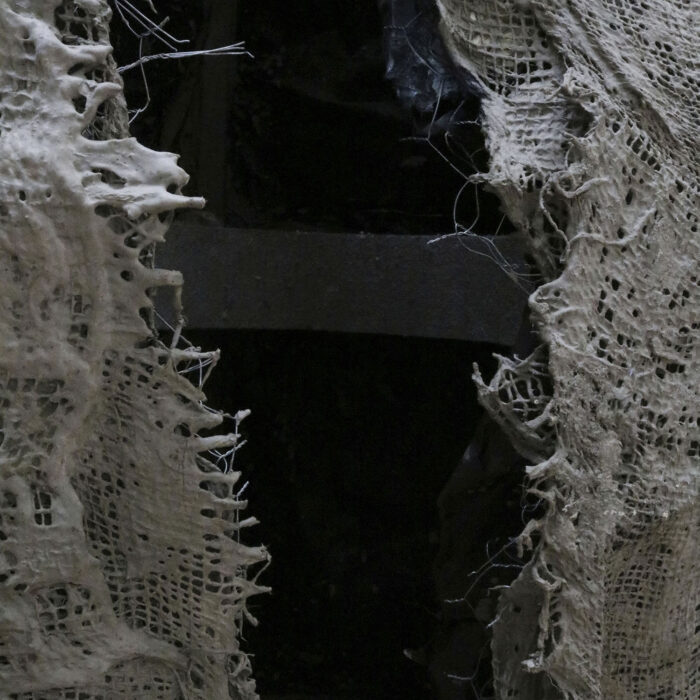Lumisokea’s Koenraad Ecker reworks three multi-channel studies on ‘Raw Materials’, using dense environmental recordings, close mic-ed, foley crunches and unsettling drones to put his own signature on electro-acoustic/concrète music.
It’s been a while since we last heard from Ecker. His last solo album ‘A Biology of Shadows’ appeared back in 2018, and ‘Raw Materials’ fills in the gaps, collecting work he wrote between 2018 and 2020. ‘Transparent Bodies, Submarine Roots’ was penned in 2019, and was originally commissioned by Cristian Vogel for Audiorama Stockholm, Sweden’s first listening venue. Spanning 16 minutes, the piece uses sounds recorded at the Belgian North Sea and around Berlin on mics, piezos and hydrophones (underwater microphones), teasing the elements into lengthy clouds of noise and sickly tones. There’s a strong sense of narrative here from Ecker; he doesn’t just use sound for sound’s sake, he takes us on a journey into unseen places. There’s none of the expected Berlin street chatter, and the expected sloshing sea sounds are inevitably transformed into unyielding, frozen whooshes and whirrs, interrupted by alien gurgles and evocative foley scrapes.
And although ‘Furniture Rebellion’ is shorter at just over three minutes, it’s no less gripping, setting the scene with lighter sounds and the distant flicker of neon lights, and bringing us into a what might be an office, or a warehouse. Ecker describes the 2020 composition as “a short story” or “a foley-study”, and it plays out like theater, only fraying the edges of the soundscape when absolutely necessary. Recorded at Berlin’s Studio für Elektroakustische Musik in 2018, ‘Heart of a Stone’ was originally commissioned by Cristian Vogel for Sentralen Oslo, and is the album’s ugliest, most fantastical composition. Here, the source sounds are obscured completely, turned into crackling, eddying crunches and subterranean wails that transport us off planet for a few moments. This isn’t trad concrète fetishism by any means – Ecker uses his sonics to pick the fantasy out of the natural world, and suggest a more foreboding presence just outside it. Another very strong release from Richard Chartier’s Line imprint.
—boomkat.com
The album starts with a splash, a quick dive through a silvery veil of sonic bubbles that quickly transforms to crackling, evaporating static. Pulsing waves of slow hiss follow, rising and thickening and pulling the listener further into the uncertainty of the echoing, undulating depths.
Welcome to Belgian musician and sound artist Koenraad Ecker’s Raw Materials, his latest album for Richard Chartier’s LINE imprint.
Ecker’s earlier work with his other projects, Lumisokea, with Italian musician Andrea Taeggi, and Stray Dogs with fellow Belgian musician, Frederik Meulyzer, feature seamless combinations of bristling drones, elements of noise and musique concrète, propulsive industrial-style rhythms that are both nimble and sharp-edged, and assiduous attention to sound production.
With Raw Materials, Ecker takes a different tack. In drawing on close-up and immersive recordings of water, stone, and in one case, the sound effects of domestic life, Ecker is looking to make rudimentary elements speak. To do so he fashions sonic narratives, defamiliarizing assemblages of sound, that become sites of buried and accumulated histories.
Across the 16-minute span of the opening track, “Transparent Bodies, Submarine Roots,” the listener is plunged into and pulled through a dizzying array of watery contexts that conjure resonant scenarios. Resting and gently bobbing, cork-like, at the water’s surface, before being pulled back under. Or sunk in a tub with a mercurial being of some sort that’s growling and whispering in an aqueous language that isn’t yours. Or listening to the endless, twining tunnel-mouths of squelched sponges rinsed in a tide. In each case we encounter creatures made of and from water, otherwise unheard, existing now in sound and voice. It’s no wonder that Ovid’s Metamorphoses is referenced in the liner notes.
Ecker makes tactile every bubble, splash, susurration, and gasp for air, transforming your skull into both a diving helmet and a thrumming cauldron. For the full effect, headphone use is strongly recommended.
The short interstitial track, “Furniture Rebellion,” is a Foley folly, a series of sound effects – the lighting of a cigarette, the sound of an elevator gate opening, a dripping tap and the granulated sounds of a shower – strung together to conjure a sonic portrait of domestic occupancy. All is clear until, with the sound of a cardboard box being torn open, the cues begin to overlap, blurring sonic boundaries, and obliterating the narrative to noise. The piece, a mere three-minute snip, raises more questions than it answers.
For the final track, “Heart of a Stone,” Ecker asks, What if a stone could speak – would we listen? In a word, yes.
Huge slabs are heard scraping open onto echoing voids. Rocks are swept in piles or poured out on each other, spitting out faint ringing sounds. Gritty textures scrape and grind together. It’s hard not to think of open crypts, chthonic mines, and, in this cavernous atmosphere, doomed souls, but when we reach the halfway point and a scratchy, gravel-textured voice materializes, muttering to itself as much as to the listener, the hellish connection is complete. It’s to Ecker’s credit, here as well as in the first track, that when these aquatic/lithic creatures appear, nothing about the contact feels cartoonish or cheap. The experience is instead unnerving, uncanny. A sonic equivalent to the body/machine transmutations one associates with the best of David Cronenberg, something at once eerily familiar, unnervingly intimate, and fantastically alien (think the pseudo-sentient high-chair that feeds Viggo Mortensen in Crimes of the Future.)
As Ecker himself puts it: Never inert, a stone is in a state of constant transformation, a historical witness, inscribed with the traces of successive ecologies. With his latest work, Ecker is probing our connections to these raw materials. Perhaps, in some ways, we are the raw materials Ecker refers to in his title. And what he’s really exploring is the unknowability of our own embodiment.
—acloserlisten.com


